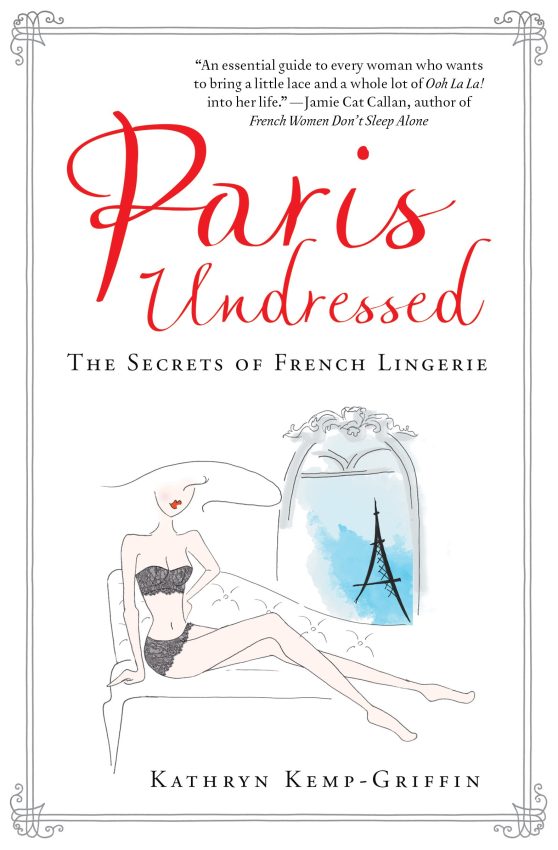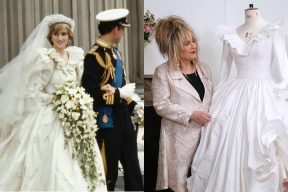When the book Paris Undressed landed on my desk a couple months ago, I have to admit I was intrigued by the tagline: “American women wear underwear. French women wear lingerie.” While I was born and raised in the Great White North, this statement still resonated with me because there really does just seem to be such a fundamental difference between how we approach our daily undergarments versus those in Paris.
The book itself, which is out now, goes through the fine art of dressing in lingerie, from the fabrics to the styles and why nude bras are the most boring thing on the planet (which, let’s be honest, we already knew). It gives detailed information and tips on how to find the right bra for you, but also approaches the topic of lingerie in a much different language than we’re used to hearing. Namely, it’s not about sex, but rather it’s about feel.

We sat down with author of Paris Undressed, Kathryn Kemp-Griffin, who has been working in the lingerie industry for nearly two decades to chat about why changing the language of lingerie is so important and how to find the perfect bra.
29Secrets: What was your initial inspiration for creating the book?
Kathryn Kemp-Griffin: I’d been running my lingerie company for 18 years and I was getting a little frustrated. I had started my company to learn [French], and I was never particularly worried about sales. But, it’s hard when you’re in business for yourself and I started getting a little negative about the whole thing and I started complaining about Paris”and I can’t stand people who complain about Paris, but I just couldn’t stop myself. While my husband was working in New York, I taking an online writing class to write this memoir. As I started writing about my lingerie company nothing negative came out and it really reinvigorated all these funny moments and helped me put things in perspective. Through the writing process, I thought it was interesting that I was able to turn the experience into something different. I started writing this in 2007 so I’ve actually been writing this book for nine years, which doesn’t sound like it when you read it.
You hear that from a lot of authors that it’s a labour of love.
I got a really good agent in New York, but she couldn’t sell it as a memoir, but I was grateful that I had been able to come that far. I wasn’t fairly worried about it, so I just started going back to work on it. I turned it into fiction, which was another learning curve, but then I started writing about French lingerie itself. It took me awhile to find a language”very much like how French lingerie is made”something that is elegant and provocative, but not vulgar. I wanted to talk about everything that’s as serious as the fabrics and the design but in a way that people could understand so that you wouldn’t have to stop to Wikipedia something. I wanted to make it all flow so tat you could go to your lingerie drawer the next day and start seeing it differently. Not looking at it in a way that you’re saying I should be doing this or that, but because you want to look at it differently so that you have other choices. I wanted to change your motivation about [how and why you wear lingerie].
A lot of our culture and language ties lingerie up with sex”how do we change that?
It’s got to happen within the brands. There’s a desperate need for new language and this book turned out to be more about the language than the lingerie itself. I took that time to understand to be so comfortable in the language and in the way things were being explained. I didn’t realize that sensuality wasn’t really a part of our culture”we’re either talking about comfort or sex when it comes to lingerie”there’s no in between. I don’t ever hear that in France. Comfort is like, yeah, duh, I wouldn’t buy a bra if it’s not comfortable. Here in North America, we’re very consumer-oriented. There’s usually a free fitting at a store, but then the sales person is going to talk about the fit as if you don’t know how to fit yourself, but no one is going to ask you how you feel and if you like your breasts or don’t like your breasts. That conversation isn’t a priority for us and it’s not in our market. Most of us go shopping for our first bra with our mothers and it’s a very public conversation. When I started interviewing people about this, I would hear them describe their first bras with little rosebuds or talk about the kind of fabric. They were already talking about the texture and what they liked about their bra”it wasn’t about sex. It was already a different approach to looking at it. Now, we go after the esthetic or overall comfort as opposed to how we feel in it.
You mention purchasing the first bra. Puberty and how our breasts develop often sets the tone for what we’re going to gravitate towards for the next decade. How can this book sort of change that mentality?
That kind of talk of either hiding and accentuating [your breasts] is coming from that language that you’re reading. I’m hoping that this book is just going to introduce a whole new language to understand”that’s why there’s so much on fabric. There’s more to it than just a well-made bra. A well-made bra means that it’s more expensive, but what does it mean for me? If you start thinking about the feeling of it, you lose the judgement part. Not many people know how they feel in something or they don’t know how to put more words to it that say “I feel more confident,” or “I feel sexier.” We add those on because we think that we should be adding them on. What about words like “soft” and “smooth” and “caress””we have a ton more words that we just don’t see. Even the word minimizer”why should I be minimzing? Seam bras are the best fitting bras because every single seam is like an arrow and it creates a silhouette”if you do a minimizer, it just spreads everything out. Looking at something like the T-shirt bra: Why are you wearing this? Because suddenly you cant show nipples under a t-shirt? Says who? It’s because the consumer thinks it’s safe.
Your section on the T-shirt bra made me laugh. But, realistically, there are certain industries and corporate environments that dictate a certain dress code”how do you balance that?
I guess, if that’s really a question, you need to ask yourself why. Is the real reason you’re a t-shirt bra on a Saturday because you think that you’re going to lose your job? No. I don’t think anyone is doing anything wrong, I just want to introduce some new options. If you still want to wear that t-shirt bra, go ahead”if that’s what you feel comfortable in, that’s fine, but at least you have a choice.
You called the nude bra dull, but it’s really the only thing that you can’t see under a white shirt. Even white under white you see.
And? What happens after the and? Is it because you think you can’t or what? Is it because you didn’t know what other options are out there?
I guess that’s the fundamental difference is changing the mindset and approach. I don’t think I’ve met one woman who doesn’t have an issue with some part of her body.
Exactly”and it always comes out in the bra. It took me nine years to write and it took me this much time to pool together. Hopefully I’ve been able to bring the information together concisely.











